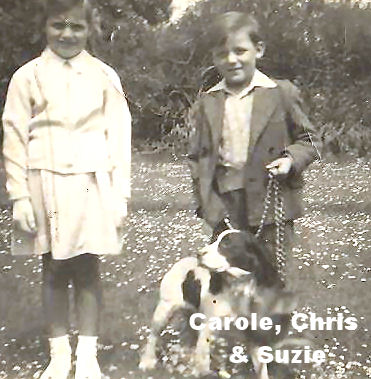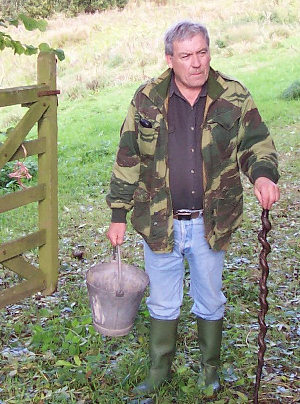 Chris Beer feeding pheasants in Winsham. |
The Chris Beer Story Chris Beer was born in 1944.He spent his young life living in Winsham, and now lives in Chard. Below are some of his memories. Also included are some rare photographs of Winsham and the surrounding area, taken around the turn of last century, and which have been handed down, and which he is now generously sharing with the Winsham Web Museum. |
.jpg) Chris and twin sister Carole at Whatley Cross in 1949 |
The
story of Chris Beer is an interesting one. He now lives in Chard and has
done so for many years. However his story shows that although people
have moved out of the village, often for housing or work reasons, they
still maintain their association with the place of their birth. Chris is
still in the village several days a week, tending his vegetable plot on
Geoff Peacock’s land.
Chris
is the son of Nora Beer, the daughter of William and Ethel Beer
(Phelps). His twin sister, Coral lives in Taunton. In
his early years he lived at Whatley Cross and for a while at 2,
Malthouses, at the end of Court Street. The Beer family was one of the
oldest in Winsham, the first record showing a Henry Beere born in
1643.There were probably others earlier than this.
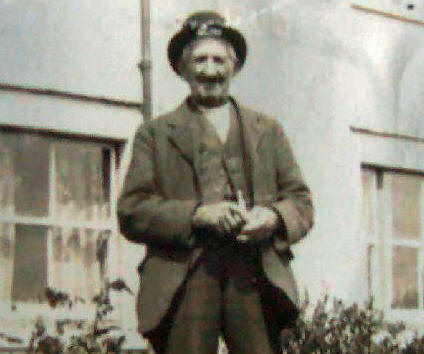 Jimmy Hoare, the father of Alice Beer was born in 1843and died in 1937. |
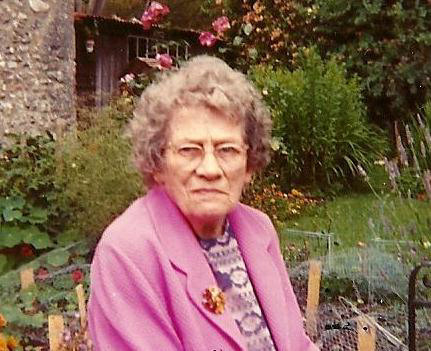 Ethel Beer was born in West Street (now Western Way) in 1888 and died at age 91, having had seven children. |
Educated at Winsham School, he became an apprentice tool maker at age
15, at Brecknall Willis, but finished his apprentice ship with
Duoalloys. After a break at Westland’s, he returned, working at
Brecknell Willis until he retired in 2010. He is married to Margaret,
and has three children, Stephen, who lives in Chard, Jayne who lives in
Tatworth and Jacqueline in Bristol.
His
memories of his early life cover many aspects of village life. His
Grandparents, William and Ethel Beer lived in a cottage called ‘Clayplatt’
which is now transformed into a house called ‘Clay pots’, which was then
on Harold Hammett’s land.
Grandfather was Harold Hammetts’s cow man. Sadly William died at age 56.
The cottage in which they lived was a ‘tied’ one, and this could have
resulted in Ethel losing her home, but Harold Hammett agreed that Ethel
could continue living there in return for managing the egg production on
the farm and doing some cleaning in the farmhouse. Chris’s family had
always held Harold Hammett in high regard, and this support at a very
difficult time justified this respect .
Another fond memory is when Chris and Carole ,walking home from Winsham School, found at Whatley Bottom, a package lying in the field. They thought it was a roll of binder twine, but when they got it home, they put it in the shed. Their mother found it later on. She brought it indoors, unwrapped it and found that it was a big cheese. The family lived on cheese for about two months!
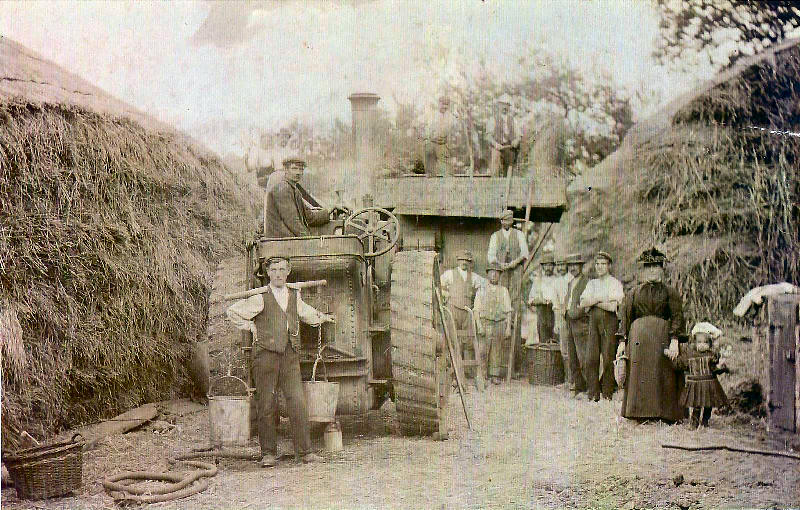
William
From
his early years, his great Gran (Alice Beer) features large in his
memory. She lived with her husband Arthur in a cottage in Broadenham
Lane. Although the cottage is long gone, there are still traces of their
residence. Hops still appear in the hedgerow; a rose also still
survives-it is known by the family as ‘Granny's Rose’. Alice and Arthur
had ten children.
| Alice Sophia Beer and Children (C.1942) -Back Row(L to R): Sid Beer, Wilfred Beer, Arthur Beer, William Beer, Charles Beer, Ken Beer. Front Row(L to R): Rose Phelps, Edith Beer, Alice Beer, Lucy Beer, Winifred Beer. |
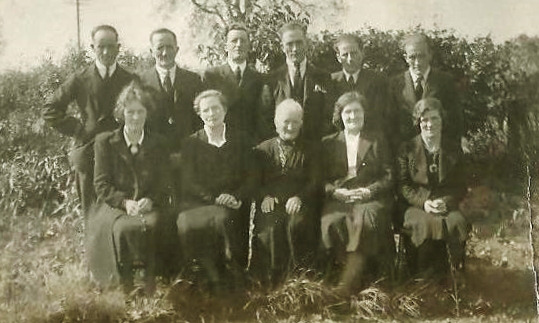 |
Granny Beer was quite a character from all accounts: she smoked a
clay pipe filled with a dark ‘shag’. On Saturday evenings she would go
to the ‘Old Kings Arms’ and have a glass of Stout (a dark, strong beer
similar to Guinness). If there was a dance being held in the Jubilee
Hall, she would go across to the hall; the Band would then play a Polka
for her to dance. Satisfied, she would return home.
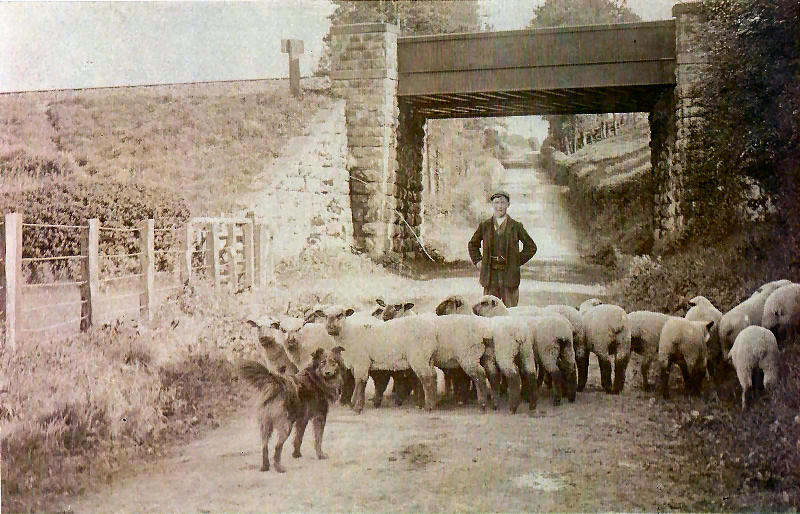 William Beer near the railway bridge in 1906 |
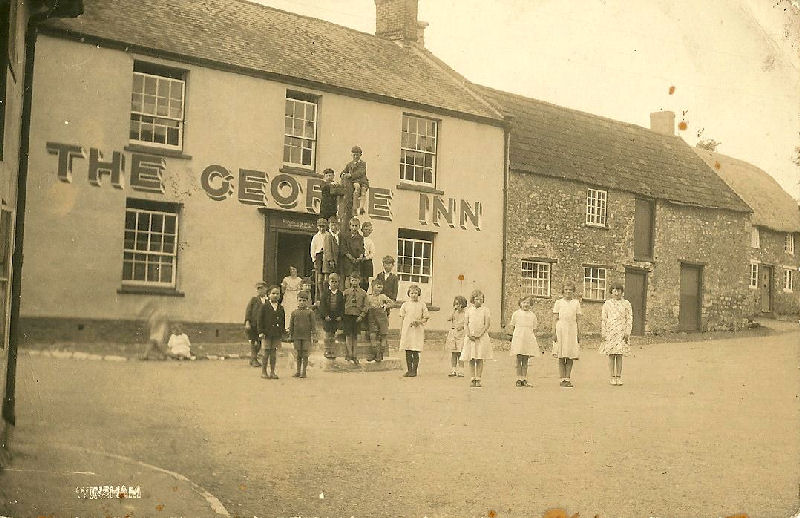 |
Chris
has happy memories of his life at Whatley Cross. Always interested in
country life, he remembers helping Graham Strawbridge make ‘spar gads’,
the hazel pegs used for thatching. They were often used in the thatching
of hay ricks, which in those days were thatched with reeds. An area of
farm land, called the ‘rick yard’ was set aside for this form of storage
that has now disappeared. When the rick was nearly all used, down to the
last three or four feet, the base of the rick was surrounded with wire
mesh, with the purpose of containing the vermin that were always
present. When the rick was nearly used , terriers were put into the
enclosure, which became a ‘killing field’. Large quantities of rats and
mice were killed, and the dogs worked to near exhaustion.
|
Suzie used to come ferreting rabbits with us when we
were kids. She always sat in front of a hole that we had missed
and hadn't netted up.
Sometimes
we came home with 20 or 30 rabbits which didn’t go to waste.
During the war country people lived on rabbits, and
after the war, when things were still on ration, if you lived on
a farm in you never went short of food.
One of my favourite pastimes was foraging for food
in the hedges, fields and woods.
We soon learnt to eat what was good and what wasn’t!
Blackberries, damsons, bramble tips, pignuts, the tuber from the
wildflower of the meadows. Wild watercress in a cheese sandwich
was heaven.
Trout and ells from the Whatley brook and a duck or
a pheasant now and again if you had your catapult with you. We
also got used to drinking cider; you could creep in and help
yourself from the barrel when no one was about. You always carried a pocket knife with you and a small oil stone; a knife was no good if it wasn’t kept sharp.
People didn’t turn their nose up at road kills, if
it wasn’t knocked about to much. A dead deer on the side of the
road was soon gone. Gran used to say "Bring thik thur pheasant
on boy ell be o.k."
Swedes
and turnips were always good to eat in season and you have never
eaten greens until you have had turnip greens, when they start
growing out in Feb and March. Strong, bitter and wonderful. Kale
tops were lovely to eat as greens as well, and field mushrooms
were always about in late summer. You had to get up early before
at dawn to pick them before other people were about.
During the school holidays on a hot thundery day you
could set fishing lines for trout. If you left
them
for a couple of hours and then pull them out, you would come
home half a dozen nice trout, sometimes more. Sadly, banks are
overgrown with Balsom and the upper reaches of the River Axe is
dead, destroyed by modern farming methods. Slurry running
off,
into the bed of the river has bunged it up and there are no
gravel beds for fish to spawn.
I
am glad I grew up when I did. I have seen the countryside when
it was clean and healthy. Let’s hope it will be like it again
one day. |
Harvest time was another excitement. He loved to watch the tractor
driven wooden threshing machine at work. A team of men kept a steady
flow of wheat or barley feeding the voracious machine, while others
filled large sacks from the side of the machine. Although the filled
sacks weighed two and a quarter hundred weight (115kg), the men carried
them on their backs to load them on to the horse drawn awaiting carts.
School was often missed when the harvest was being gathered. The milling
of the seed was usually carried at local Mills. At one time there were
five mills along Whatley Brook. Chris does not have any memories of any
of these working, and most were derelict. There were mills at one time
or another at Purtington, Hollowells, Whatley Bottom, Guys Mill, and
Ammerham.
Chris
often went wandering through the local woodlands. He remembers switching
eggs from Jay’s nests and Blackbird nests, and observing that the
parents still brought up the nestlings as their own. He did the same
with Magpie and crows, with the same result!
Children could wander across the Cricket Estate and the surrounding farm
land without hindrance. He admits to doing some scrumping with his
friends, and recalls when Freddie Saunders (Mrs Pam Hammett’s father )
caught them hiding in one of his chicken houses-he just locked the door
and left them there for several hours.
Mrs
Hall, the owner of the Cricket St. Thomas estate, a large employer of
Winsham people, was very popular. Chris remembers that she drove a large
red Mercedes. Sometimes she would invite children playing around the
estate into the garden of Cricket House to enjoy cakes, and lemonade
(made with lemonade crystals).
At
this time, the Lawley family owned Leigh House. Miss Lawley, a daughter
of the house used to drive around in an ancient Rolls Royce. In addition
to going to St.Stephen’s for the regular Sunday morning service, he and
his sister would go to Sunday school. Miss Lawley would regularly pick
them up on Sunday mornings to take them to Sunday School in her Rolls
Royce. Chris remembers that the only sound he could remember on these
short drives was the sound of the clock that would tick away on the dash
board!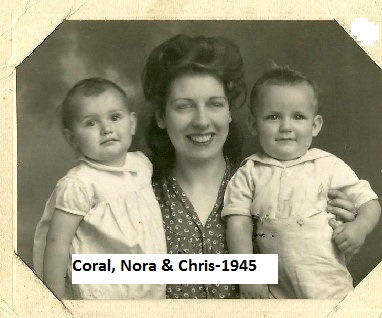
Despite his love of the countryside, Chris was also interested in
mechanical things, which led him to spend a lot of time in Churchill’s
in Fore Street, where Neddie Churchill encouraged this interest which
indirectly led to him becoming an apprentice tool maker.
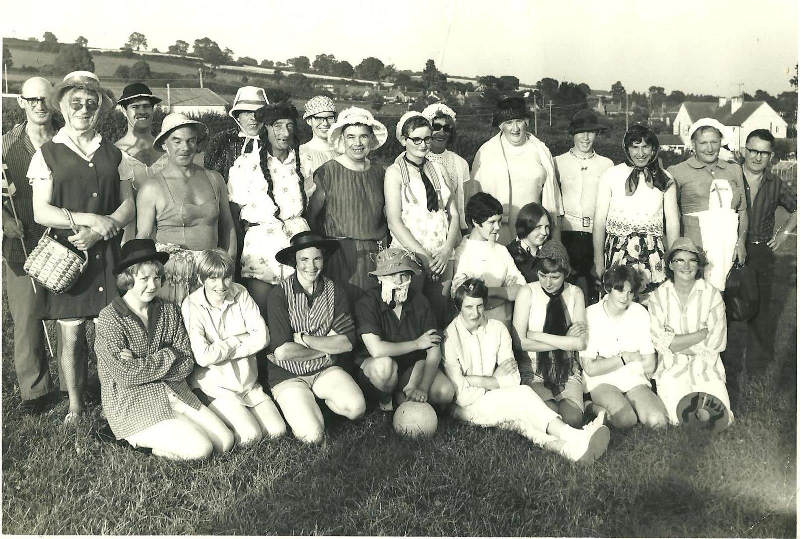
Chris
also remembers the blowing up of the cottages down near the River Axe,
adjacent to the old wool mill. Pat Wheadon used the debris for repairing
aerodromes in the Somerset area. John Jeffery, who died in recent years,
and who lived at Beere Farm, was
given the task of pressing the button that detonated the explosion.
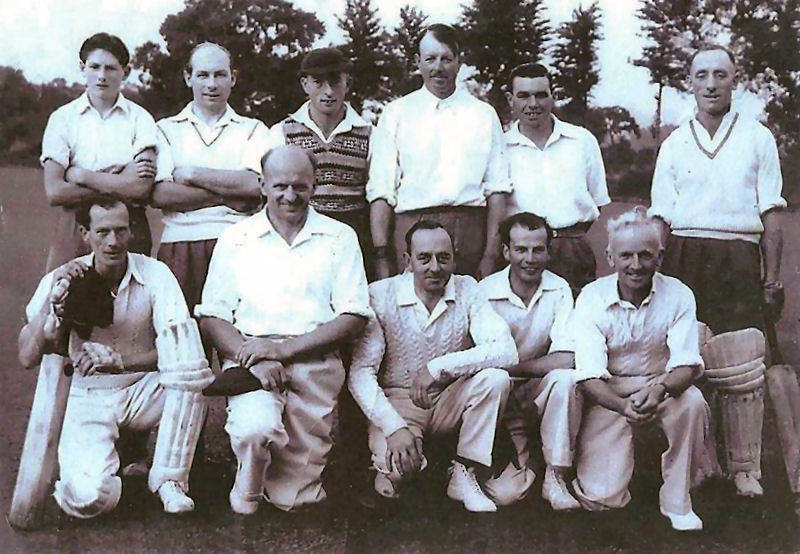
Cricket St Thomas Cricket team
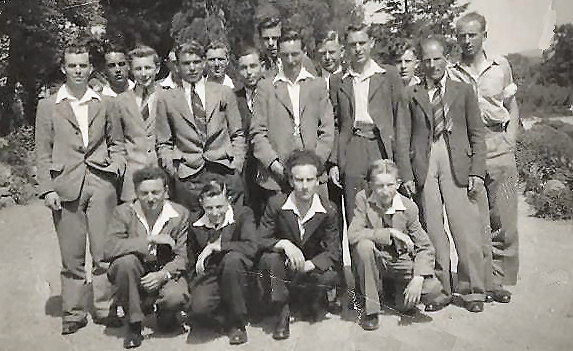 ' The Winsham Lads' circa 1950 |
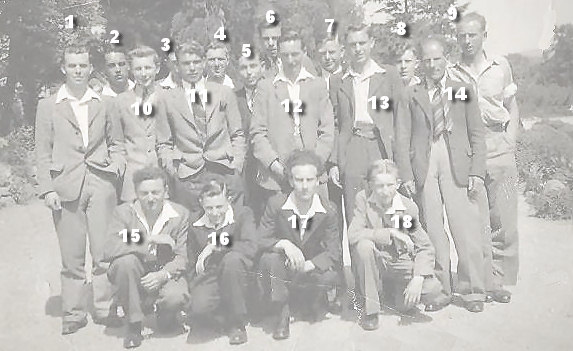 1.Alan Spurdle 2.Cecil Partridge 3.Bernard Mildon 4.Dennis Paull 5.Alan Ewings 6. John Spurdle 7.Son Partridge 8.Fred Down 9. Arthur Loaring 10.Bernard Milden 11.Ray March 12. Howard Grabham13.Rex Phelps 14.Charley Beer 15. Fred Long 16. Norman Good 17.Alfie Phelps 18. Norman Phelps |
|
Winsham
Wally From more recent years, Chris has memories of the ‘Winsham Wally’. Believed to be a fugitive from the now abandoned menagerie at Cricket St Thomas Wild life Park, the wallaby had been seen fleetingly in various parts of the parish. Chris spotted it in Verdhay, part of Geoff Peacock’s land, something that Geoff initially did not believe until he saw it for himself. Over a period a good relationship built up. Chris was allowed to get within a few feet, but no closer. Geoff and Chris considered building a winter shelter for it, but then it disappeared. It was next heard of in Lyme Regis, captured and sent to a Wallaby haven near Axminster. Reading this report in the Western gazette, he called the Haven, and went to visit .Armed with photographs, he was able to positively identify it as the Winsham Wallaby. He was asked if he wanted it back, but decided that it was better off left where it was. |
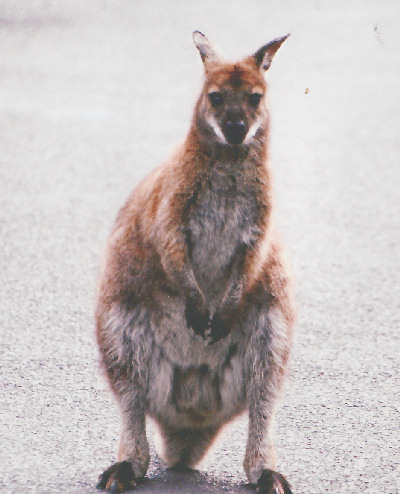 |
More pictures - Click HERE
